Home » Other Articles » Tuesday Treasures Index » Tuesday Treasures - May 2023 - Tuesday Treasures - May 2023
Tuesday Treasures - May 2023
TUESDAY 30 MAY
Railways as Common Carriers – Part 2
In our Tuesday Treasures of November 2022 we introduced the legal obligation on all privately funded railway companies to be ‘common carriers’, by which whatever they were requested to carry, they had to have a ‘reasonable’ tariff, or cost, publicly available for that service. If one wasn’t already in place, they still had to create one if it was a consignment they hadn’t previously catered for.

The notice of Race Horse services, now in the Great Western Trust collection
Our blog today, from our Great Western Trust collection is based upon the remarkable public notice (illustrated) of the GWR train services offered to racehorse stables and owners for the key races in England from 8 to 21 June 1939. We are probably familiar with Doncaster, Ascot, Windsor & Folkestone Races, but Gatwick too?
The notice is slightly larger than foolscap (13 x 8 inches) in size and on this single sheet perhaps the most interesting revelation is that contained in the framed small printed section on the far right hand side, in which we are advised that the GWR owned a Road Motor Horse Box, which for a set fee could be hired from Swindon, to carry one or two horses within a radius of 25 miles.
The notice itself was probably issued to all known race stables but this remarkable survivor has official GWR annotations including a rubber stamping of the GWR Superintendent of the Line which infers it was a proof copy that his staff kept for reference, although that stamping has a striking ‘X’ upon it, and the pencilled ‘XR’ above the title, might indicate it was withdrawn? Sadly, we have yet to find records of these official procedures and their coded annotations!
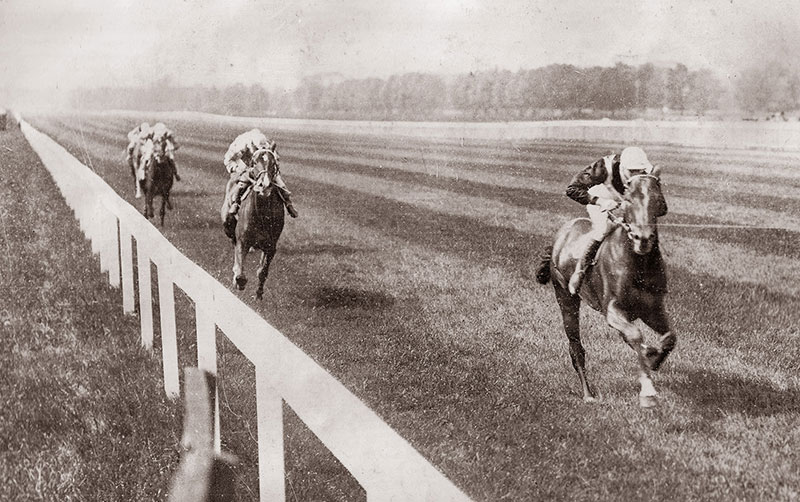
Before it was an airport, Noble Star (right) winning the Home Bred Cup at Gatwick on 23 May 1930. Noble Star was trained by Leonard Cundell at Chilton, near Didcot, with Upton and Blewbury as the local railway station
On the GWR system itself, the most established and successful racehorse stables were at Lambourn and that rather humble branch line to Newbury provided the GWR with numerous racehorse special traffic in its lifetime, now sadly long closed and lamented, not least for the glorious countryside it passed through.
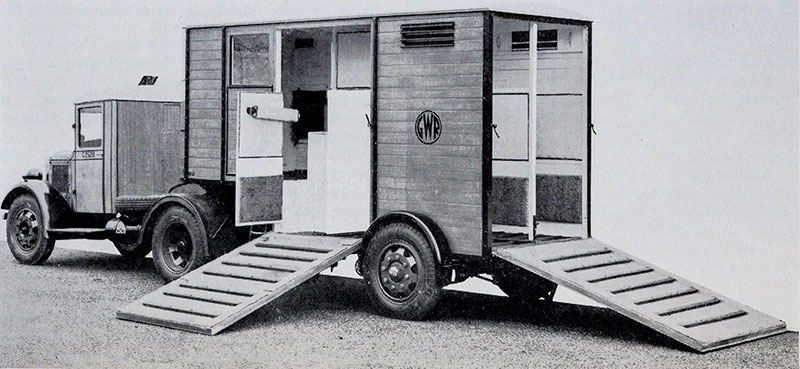
The GWR’s road motor horsebox, available to hire within a 25 mile radius of Swindon
The Great Western Railway Magazine in its August 1937 edition, described the working of special trains for racehorses:
“For practically every meeting a special timetable is worked out, showing the latest entraining times at the different training centre stations, arrival times at destination and return train arrangements, and a copy of this is sent, well in advance of the date of the meeting, to every trainer affected.
“The horses, when loaded, are worked through to a central point where the specials are made up. Whenever possible, and the Great Western Railway Company makes a special feature of this working, the specials are run to the courses and back in the same day, and even at such distant meetings as those held in Scotland, horses, boxed the previous night, arrive early the next morning.
“Race-horse specials are treated in the same way as express passenger trains. They carry the same headlights, and must not be delayed. At times they are booked to run over certain sections of the line at speeds up to 50 m.p.h., and it says much for the level and steady running, characteristic of the railways, that these highly-strung animals are fit to race upon arrival. That they travel better by rail is generally agreed by trainers.
“This year the Grand National provided the railways with an excellent testimonial. The first four horses past the post were all rail-borne, the winner being trained on territory served by the Great Western Railway, and ‘trained’ by the Company to Liverpool. Mid-day Sun, the Derby winner, is also a ‘Western’ horse.
“Sometimes a special train is ordered at the eleventh hour – for the ‘dark’ horse who does not figure in ‘the above have arrived’ list, but who, nevertheless, arrives in good time, and in fine fettle for his race.
“The care of race-horses en route is of paramount importance. Before each journey, every box is carefully examined, and immediately after use thoroughly cleansed and disinfected by special staffs working to the most stringent instructions.”

Loading racehorses at Lambourn
The Great Western Trust archive hold numerous other GWR records of race events and train adverts. Probably the GWR itself was delighted when adjacent to its express route, the Newbury Racecourse was established with its very own station. We know that they used that station to provide very popular Newbury Race specials for its Race Course Members, one most important passenger on these was the late HRH Queen Elizabeth the Queen Mother no less!
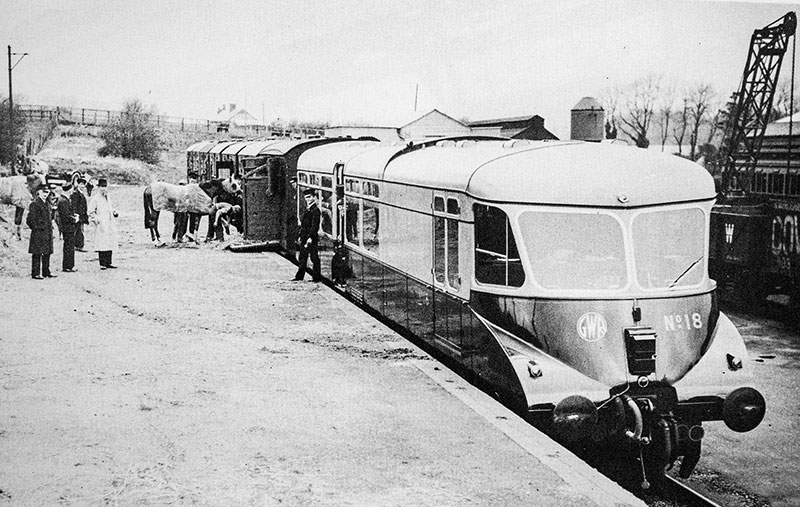
The new diesel railcar No 18 in 1937, which was able to haul horseboxes on the Lambourn branch
Lest we overlook its date, June 1939 was only a few months away from World War 2, and all the horrors it delivered. Ahead of that looming threat, we can hardly dismiss the distractive attraction of a ‘Day at the Races’ for those folk who enjoyed such sport. Gatwick became an RAF base at the beginning of the war and in the 1950s was expanded to become London’s second airport, with a runway built across the former racecourse.
TUESDAY 23 MAY
The Golden Hind Express
Whilst the Great Western Railway had its famed named expresses, the BRWR era created its own, at least for a while, and one such was The Golden Hind, named after Sir Francis Drake’s famous ship which he sailed round the world between 1577 and 1580.

Our Tuesday Treasures Blog today, illustrates the striking image that was published on the back cover of the British Transport Commission publication Transport Age No 33 of Summer 1965. In fact it was the last year of its production, which had begun in 1957 and was available widely for two shillings and sixpence (pre decimalisation money).
From the small caption to the picture, and the image itself, the train was clearly designed and timed with businessmen (yes a male dominated profession then!) in focus.
The Great Western Trust also holds the menu for the inaugural run of this train on 15 June 1964. The front cover and centre spread are illustrated here.
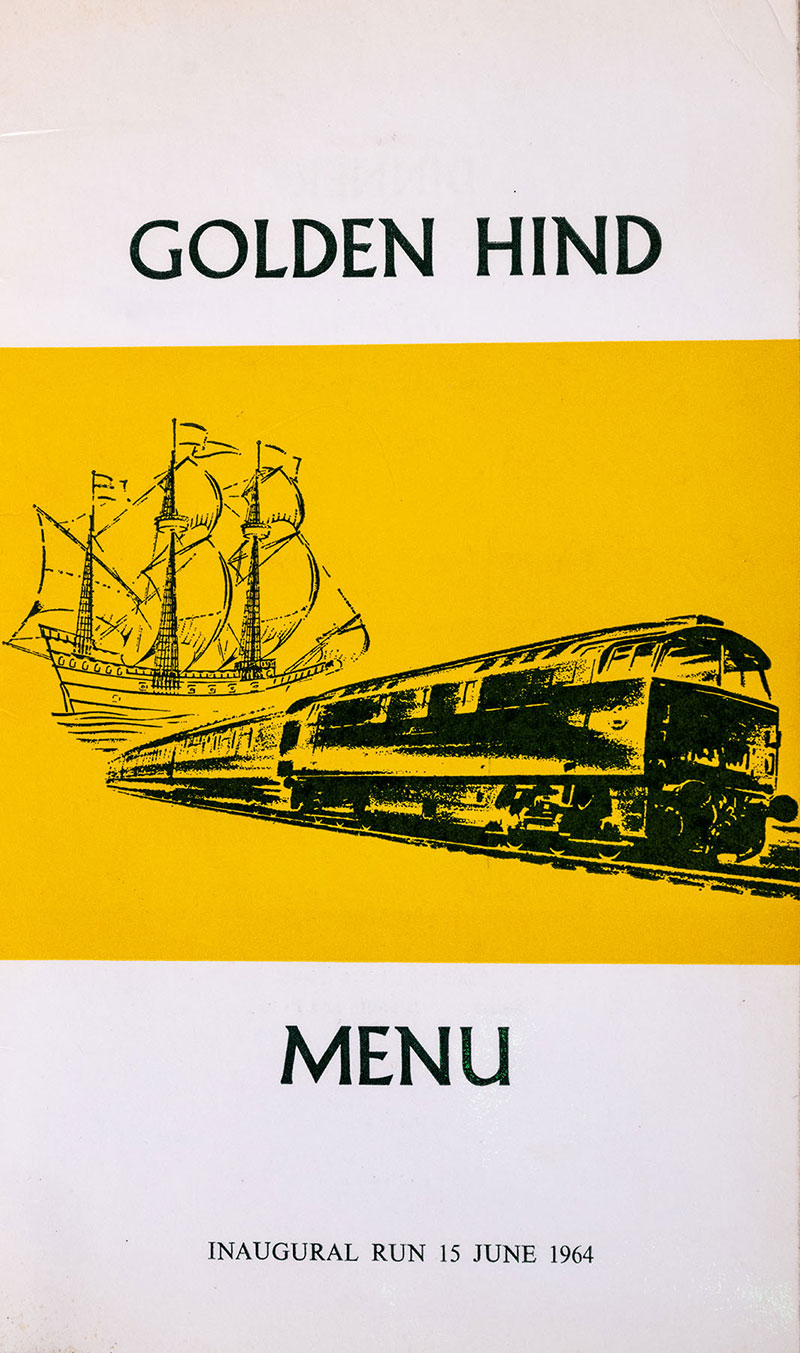
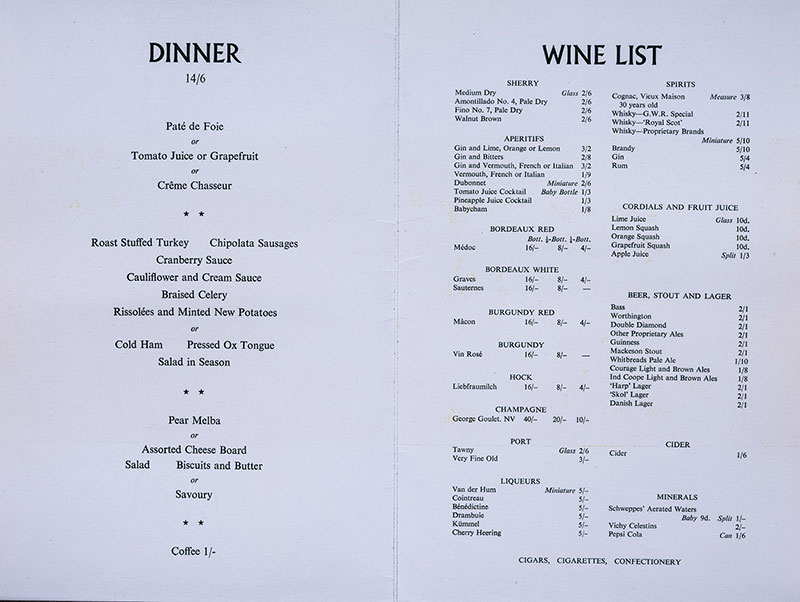
Restaurant cars are now very nearly a thing of the past, and their era is reflected in the Great Western Trust’s collection of publications and internal documents covering the staff rules and conduct, and their splendid uniforms. The art of serving hot coffee on trains at express speeds was an acquired skill much admired by regular business travellers!
The Railway Magazine reported the inauguration of The Golden Hind in its May 1964 edition:
“A ‘fastest-ever’ businessman’s service between Plymouth and London, named The Golden Hind, will be introduced by the Western Region of British Railways on June15. The up train will depart on Mondays to Fridays at 7.5am to arrive at Paddington at 10.55am – 225¾ miles in 230 min. It will call at Newton Abbot, Exeter St David’s and Taunton, thence covering the remaining 143 miles non-stop in 127 min. In the reverse direction the train will leave Paddington at 5.20pm, make the same calls, and reach Plymouth at 9.15pm.”
A proving run was made on 8 April with a seven-coach train hauled by No 1027 Western Lancer in maroon livery. This photograph shows the train passing Ealing on its outward journey. The Railway Magazine reported:
“The run made by Western Lancer on April 8 followed the action, on the part of the Western Region, to considerably accelerate the service between Plymouth and London, the train being worked back to Paddington to the up timing of the proposed Golden Hind. The average speed of the latter between Taunton and London will be 68½ mph and on the demonstration run the 143 mile stretch was covered in 113 min, an average of 76 mph. The train included a track recording car, from which the information gathered will be used to assess, in relation to cost, the restrictions which could be eased to provide a practical running margin for a 3½-hr express with three stops”
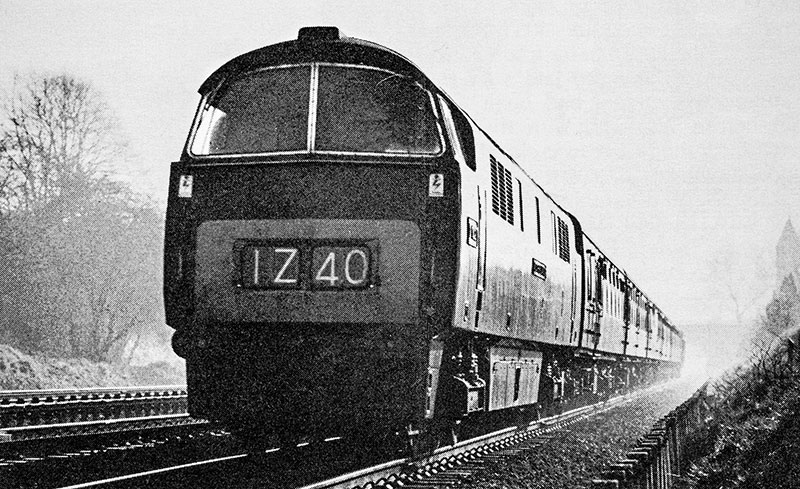
The Golden Hind was the brainchild of David Pattisson, newly-appointed Divisional Manager of the new Plymouth Division office. Gerry Fiennes in his book I Tried to Run a Railway, published in 1967, explains:
“The West Country were pretty bolshie about railways, and with some reason. The Beeching plan approved by parliament in 1963, intended nearly a clean sweep of the branch lines. The main line from Plymouth to Penzance was suspect.
David Pattisson is a shrewd operator. He set out to revive the West Country. Firstly he made a friend of one of the principal railway critics, a journalist and publisher, David St John Thomas. Secondly he did one thing. Now when you declare an intention to a hostile audience, to do one thing is vital. Nobody believes you when you tell him things; one thing done and they are on your side and content.
David did better than this, he gave the West Country a whole new train; the fastest ever run from Plymouth. Taunton to London 143 miles in 123 minutes; six D1000 locomotives ‘the Golden Stud’ specially maintained; no phoney axles; hand-picked stock; hand-picked crew for the dining car; all seats reserved; Publicity. Press trip. Television. He didn’t forget a connection from the Penzance line. He thought of and got the lot. Within a month the load factor both ways was over 50 per cent: in three months it was over 70 and going up. We were turning people away on five journeys a week.”
A few years later David Pattisson, the man who ‘thought of and got the lot’, when London Divisional Manager, allowed the Great Western Society to move its locomotives and rolling stock into the old engine shed at Didcot, and start to create Didcot Railway Centre. The heritage railway sector owes David a great debt of gratitude.
TUESDAY 16 MAY
The Kiddies’ Express
In our previous Tuesday Treasures Blogs we have mentioned the very special relationship youngsters had with steam engines and railways in general. Certainly the Great Western Trust collection has an abundance of related material, official and unofficial, demonstrating this. That the GWR recognised and exploited this to the full and once the King class locomotives had been entered into service, arranged very popular steam special trips to Swindon.

Today we highlight one major example of the way the GWR exploited that enthusiasm. The Handbill illustrated, advertises a very special train to Weston-super-Mare, dedicated to ‘Kiddies’ (ie children) with their adult relations, to run from Paddington on Whit-Monday, 16 May 1932 (the Whitsun bank holiday). The adult fare of 7/6 (37½p) is the equivalent of £21 today. The train has attraction enough surely, as its to be hauled by a King Class loco, but the GWR gave added anticipation by the BIG SURPRISE to be announced when the train was underway!
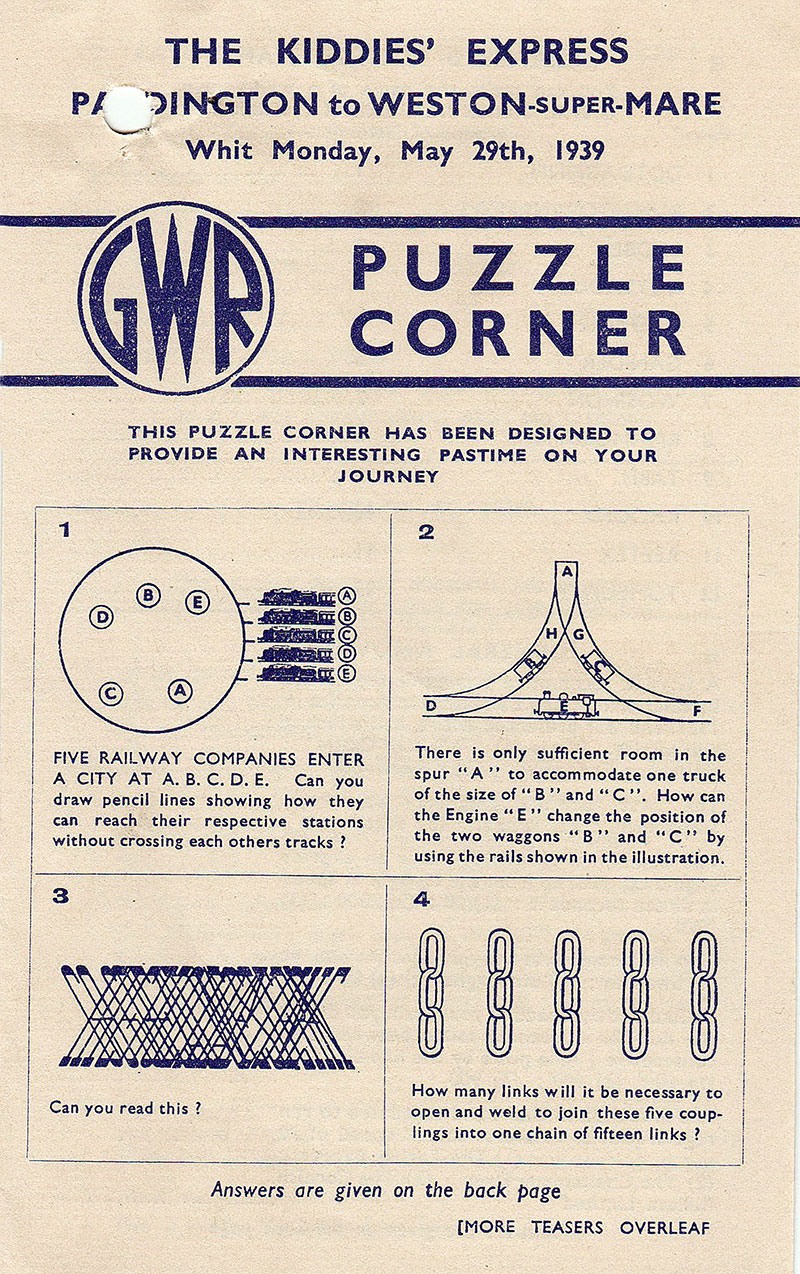
Never missing a sales opportunity, and knowing too well the hard reality of children’s ‘pester power’, the GWR cleverly included that their publications dedicated to railway enthusiasts would be on sale in the train!
The train itself, the very first of its kind, proved so popular that three trains ran on the day, when 1,500 intending passengers turned up at Paddington station! This photograph of some of the passengers was published in the Great Western Railway Magazine. In fact the initiative clearly caught the imagination of adults and kiddies alike because it ran in subsequent years, and we also illustrate the special leaflet ‘GWR PUZZLE CORNER’ issued on the Whit Monday trip of 29 May 1939. Of course if the youngsters were seriously captivated by a rail journey and loco spotting, the likelihood that they would concentrate on a set of puzzles whilst on the journey, is asking rather too much?

Such items go far beyond mere nostalgia, as they prove that far from deriding youthful interest in trains and railways, the GWR most certainly went out of their way to embrace it and indeed, encourage it.
What a sharp contrast this is to our experiences today?
TUESDAY 9 MAY
One Morning in May
This week we use the old Hoagy Carmichael song as the inspiration for our title.
We feature five photographs from the Great Western Trust collection all taken on 12 May 1956 by Philip Kelley, now in his ninety-fifth year, near Denham Golf Club Halt on the former Great Western/Great Central Joint line. Philip was an official BR photographer at the time and had access to information and locations denied to lesser mortals.

LNER A4 Pacifics were a rare sight on this line but here we see No. 60014 Silver Link at the head of the Ian Allan ‘Pennine Pullman’, a railtour that ran from Marylebone to Sheffield and back to Kings Cross after a return trip across the Pennines.

Next is an LNER L1 No. 67787 on an up local High Wycombe to Marylebone train. This Thompson-designed loco, built by Robert Stephenson & Hawthorn, was a regular performer on the line in the 1950s.
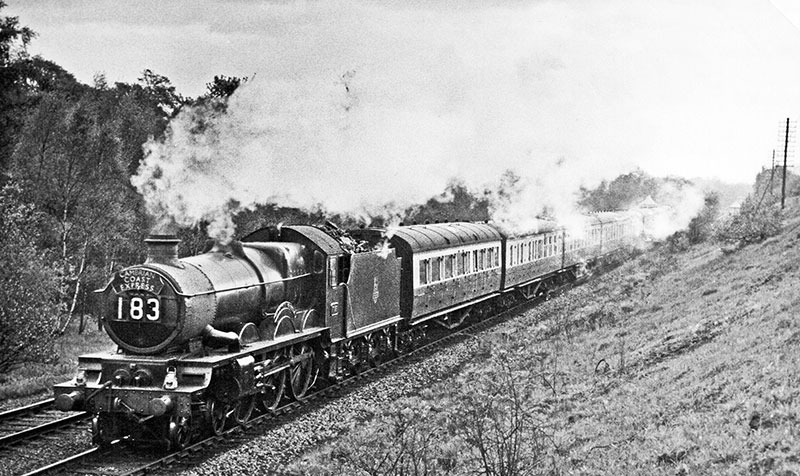
Following the ‘Pennine Pullman’ is No 7036 Taunton Castle hauling the down Cambrian Coast Express, a popular holiday train that conveyed through coaches for both Aberystwyth and Pwllheli, the furthest reaches of the old Cambrian Railways network.
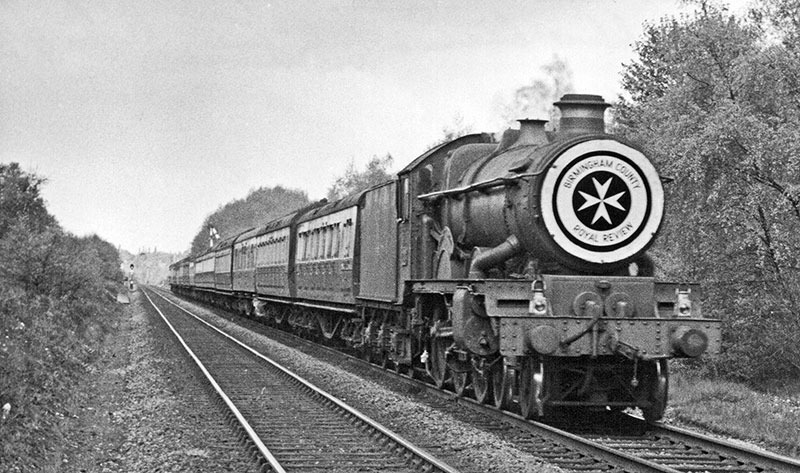
On the up line we next see an unidentified ‘Castle’ in charge of a special conveying St John Ambulance delegates from Birmingham to their 1956 convention in London. 22,000 members of St John paraded in Hyde Park, where they were reviewed by the Queen.
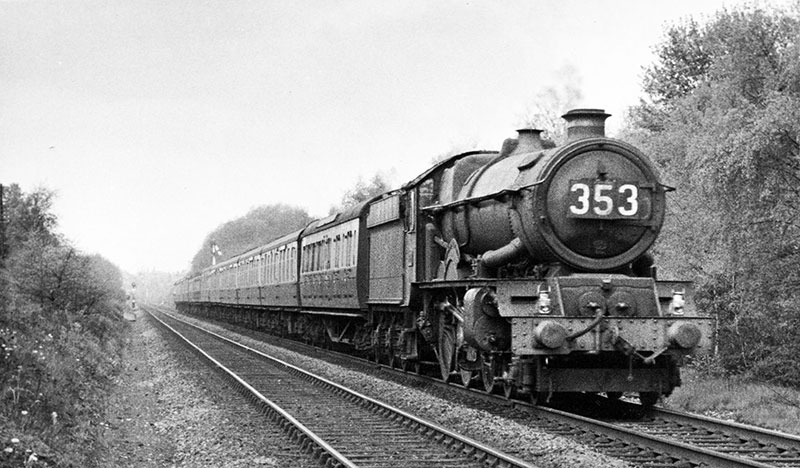
In the final photo the fireman on this unidentified ‘King’ will be running down the fire over the last few miles to Paddington at the head of the 7.30 am train from Shrewsbury.
Such was the variety of sights to be enjoyed on many main lines in the days of steam, a far cry from the monotony of current day fixed formation trains.
TUESDAY 2 MAY
A Coronation
With the imminent crowning of King Charles III it seems timely to look back at the GWR’s role in previous Coronations.

Queen Victoria was crowned on 28 June 1838, just days after the Great Western Railway opened the first section of line from Paddington to Maidenhead (actually on the Taplow side of the river Thames) on 4 June of that year. Due to her longevity, the earliest item we have relating to a coronation is for King Edward VII and Queen Alexandra originally scheduled for 22 June 1902. This booklet gives details of special trains run from major centres between Penzance and Taunton. In the event, the occasion was postponed at very short notice until 9 August due to the King suffering from acute appendicitis.
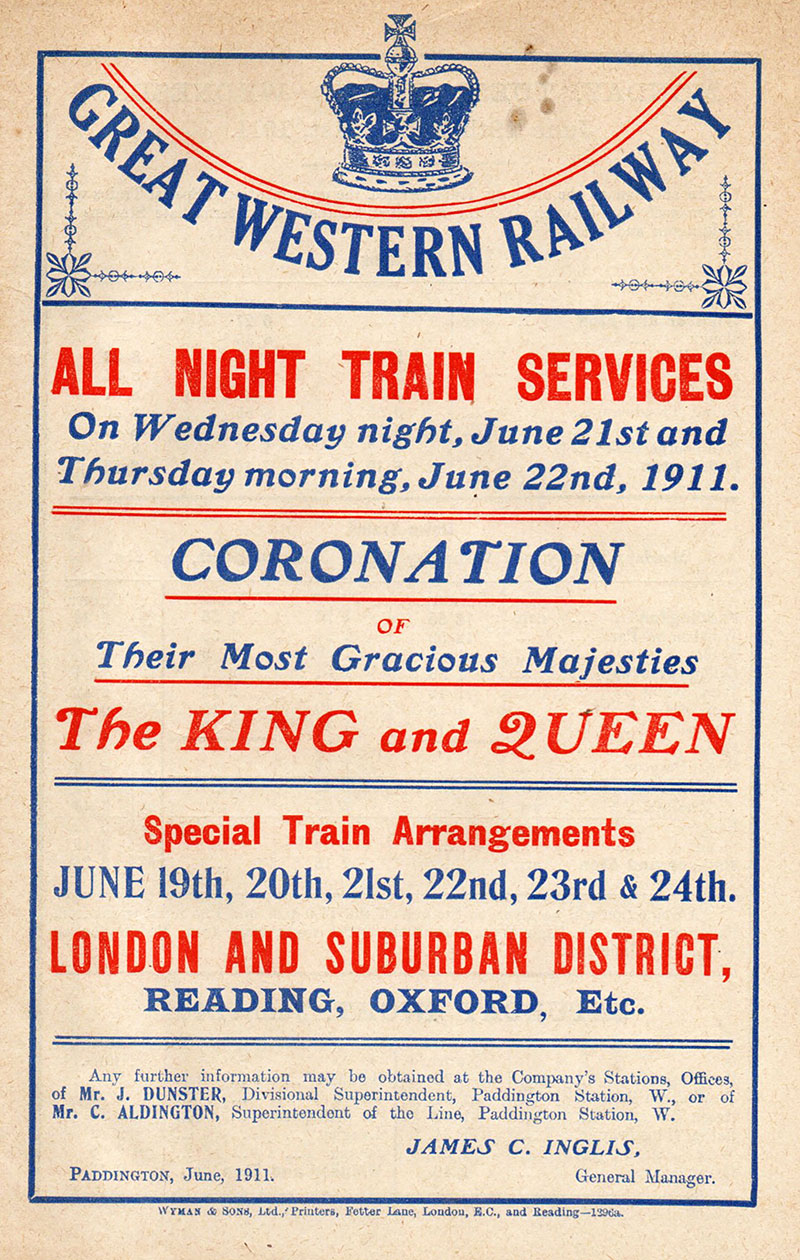
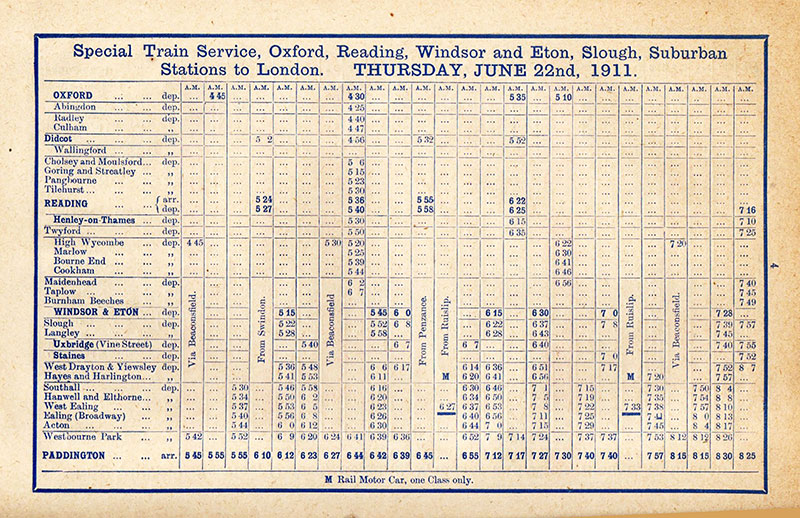
After a reign of only nine years, Edward VII died and his son King George V succeeded him, being crowned on 22 June 1911. Dedicated monarchists could catch a train departing from Oxford at 4.45 am which ran non-stop to Paddington in seventy minutes arriving in plenty of time to find a good position to watch the parade.

George V reigned for twenty five years and upon his demise he was succeeded by his eldest son, King Edward VIII. The story of his short reign is well known and in hindsight it appears that he would have been particularly ill-suited to be Head of State.
Upon his abdication, he was succeeded by King George VI who reigned through the difficult and turbulent years of the Second World War. His coronation took place on 12 May 1937 and special excursions were run from many parts. Coronation spectators could leave Dartmouth at 10.35 pm on Tuesday 11 May, arriving in London at 4.30 am on Coronation day, returning from Paddington at 3.00 am the following day. They must have been hardy souls. GWR staff who could be spared from their duties were given a day of with pay to mark the occasion.
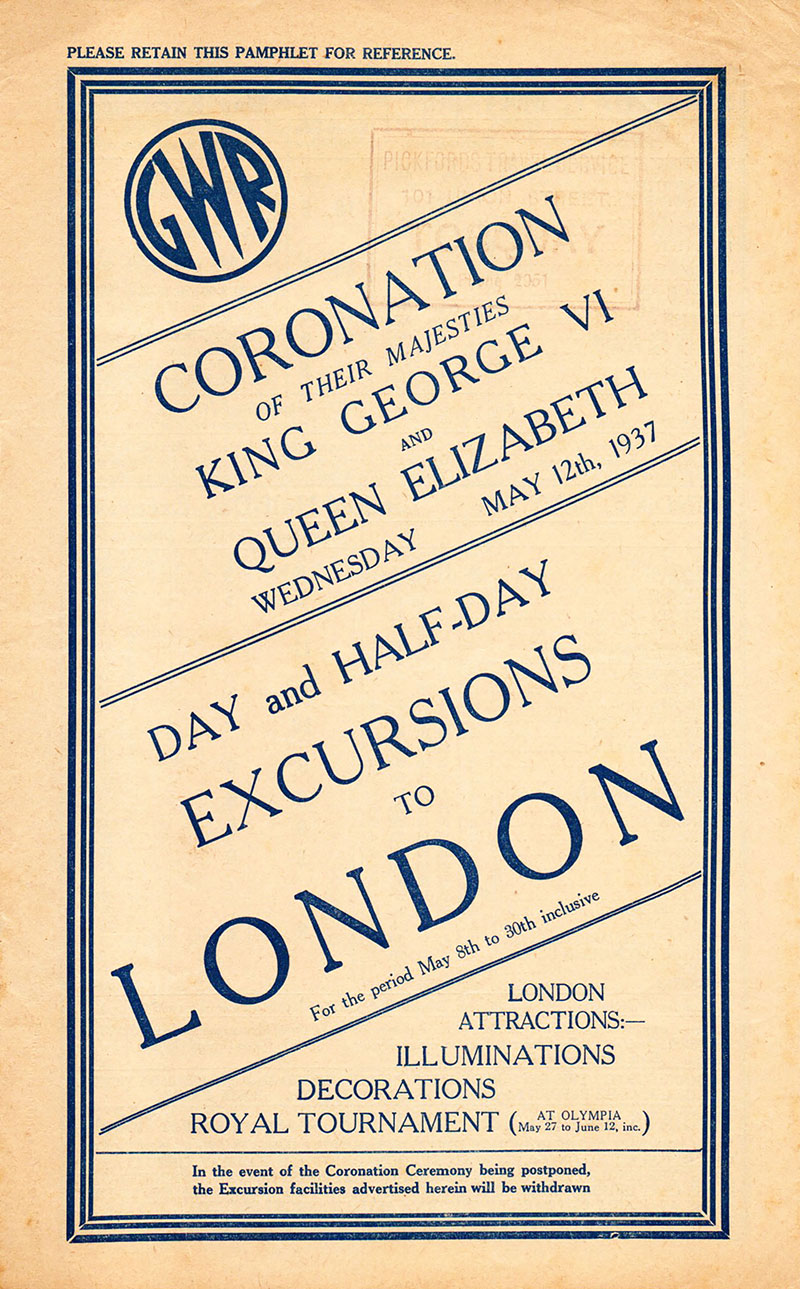
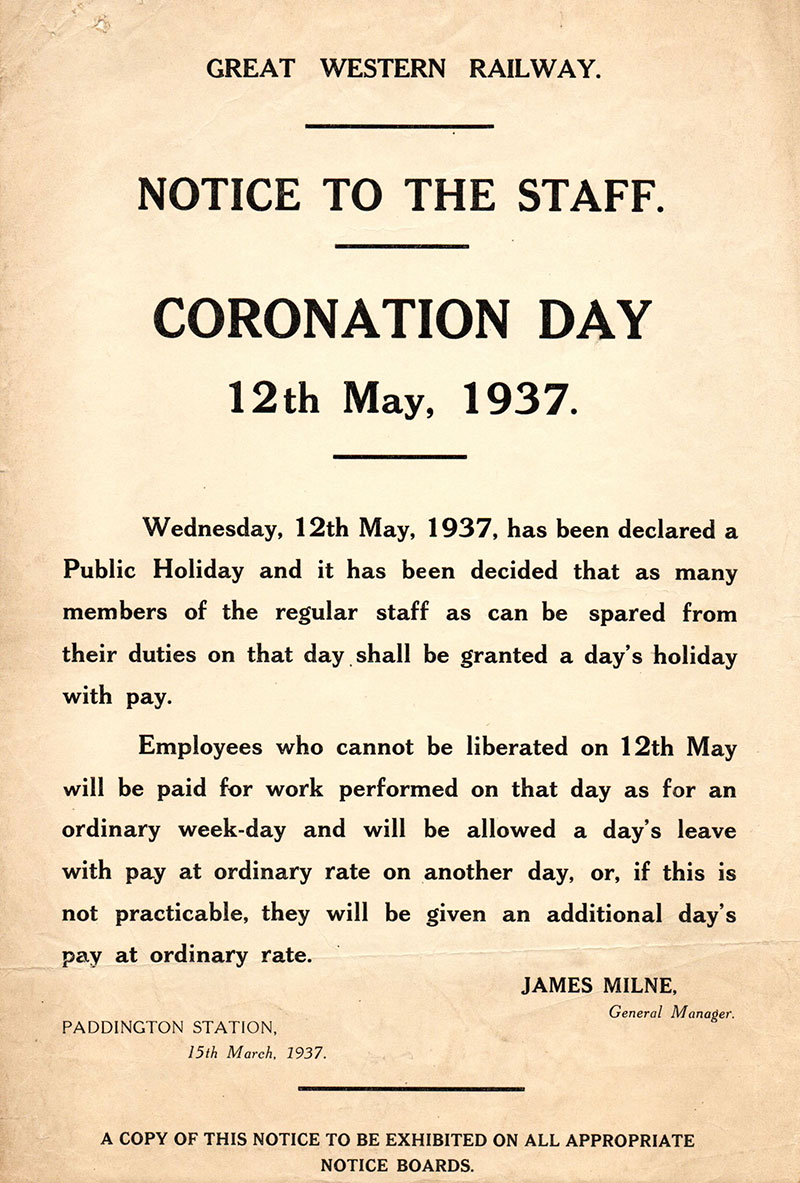
Finally we come to the most recent coronation, albeit seventy years ago, of Queen Elizabeth II on 2 June 1953. By this time, handbills and booklets were issued by British Railways (Western Region) but as in previous years many special trains were run to bring the thousands of well-wishers to the capital to view the great state occasion.
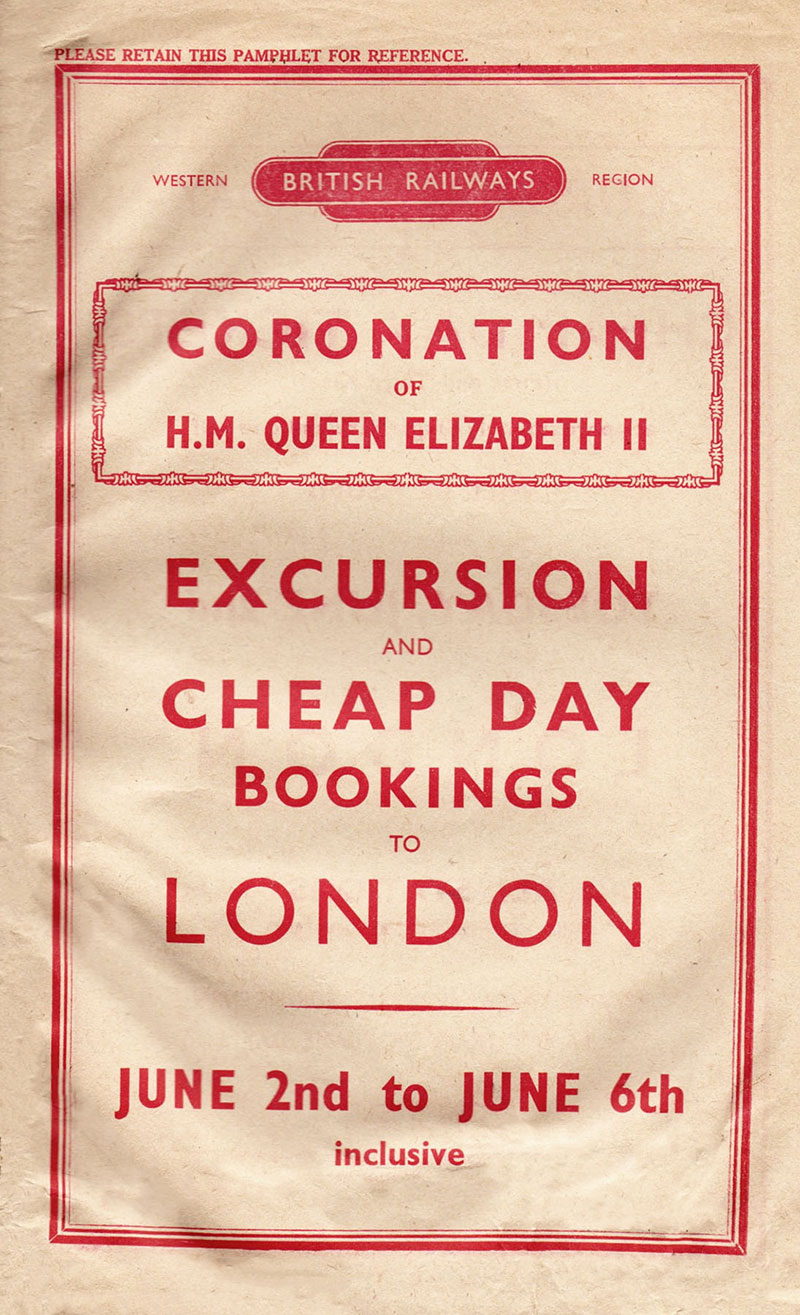
Shown here are just a few examples of the hundreds of ‘royal’ items in the Great Western Trust collection. Our own Royal Family plus visiting Heads of State were all conveyed by the GWR and more such items will feature in future Tuesday Treasures.
Didcot Railway Centre Newsletter
Stay up to date with events and what's going on at Didcot Railway Centre.
You may unsubscribe at any time. We do not share your data with 3rd parties.